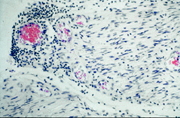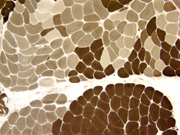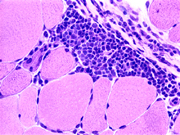M2 NEUROPATHOLOGY LAB
QUIZ 14
Read case histories A through
E. Write your diagnoses below.
Case
A
Case B
Case C
Case D
Case E
Match the case histories to images 66-70.
66 67
67  68
68
69
 70
70 
#67 is a thin plastic section of nerve stained with toluidin blue. #69 is a section of muscle with a histochemical-ATPase-stain.
Case A
A boy who was normal from birth through the first year of life, began to walk at 15 months and always had a waddling gait. He was never able to run as well as other children did. By the time he was 3 years old, he could not get up from the floor without pushing on his knees. At age 5, he could not climb stairs and began to walk on his toes. His calf muscles were bulky and felt rubbery. He was a slow learner at kindergarten. Serum CK was 2,735 (normal 3-35). His mother had a CK of 73. A muscle biopsy was done. A maternal uncle died of a similar disease at 15 years of age.
Case B
A 45-year-old woman had some clumsiness of the right
hand for three months. Her elbows, shoulders, knees,
and thighs ached. About four weeks following the
onset of these symptoms, she began to have difficulty
swallowing solid food. She fell easily, could not
climb stairs without supporting herself with her
hands, and could not get out of a low chair by herself.
Sensation was intact. CK was 887 (normal 3-35) and
sedimentation rate 42. A muscle biopsy was done.
Case C
Two weeks after having the flu, this pregnant (first
trimester) woman noted tingling of her hands and
weakness of the legs. The weakness progressed rapidly
and in 9 days she was bedridden, unable to move against
gravity or even shut her eyes. Initially, the diagnosis
of ‘hysterical reaction” was made, but
she developed difficulty breathing, had a tracheostomy,
and was put on a respirator. CSF was clear with glucose
81, protein 128, and 1 WBC. She had a cardiac arrest
and died four weeks after the onset of her illness.
She remained paralyzed until her death.
Case D
A 15-year-old boy had bilateral high arch feet, weakness
and atrophy of the legs and mild weakness of the
arms. He had no sensory loss or ataxia. CK was normal.
His grandfather, father, and uncle had a similar
condition.
Case E
A baby girl, one of twins, was 2 pounds 11 ounces
at birth. During pregnancy, no fetal movement was
felt by the mother until the eighth month. As a newborn,
she was hypotonic. She developed slowly, and, at
six months of age, she was unable to lift her head
or roll over. CK was normal. At 12 months, she was
extremely weak and hypotonic. Spontaneous movements
were apparent only in the hands and arms. Fasciculations
of the tongue were noted. Her twin brother and another
sibling died of a similar disease. Six other siblings
are normal.
ALL LECTURE PODCASTS ARE EMBEDDED IN THEIR RESPECTIVE
NEUROPATHOLOGY PAGES AND CAN ALSO BE FOUND ON THE
VIMEO CHANNEL "DIMITRI
AGAMANOLIS NEUROPATHOLOGY"